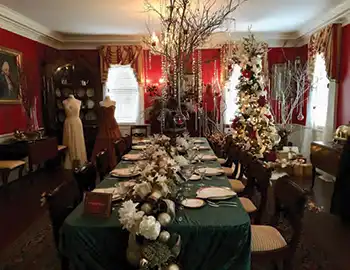
Perched on a bluff overlooking the Sampit River behind Georgetown’s Front Street is the stately Kaminski House, built in the Georgian style sometime in the mid-to-late 1760s by successful merchant Paul Trapier. After Trapier gifted the home to his daughter, it traded hands many times until Harold and Julia Kaminski purchased the property in 1931.
The son of a prominent Jewish merchant Heiman Kaminski, Harold was mayor of Georgetown, celebrated for bringing affordable electricity to the area, and Julia was the descendant of wealthy planters. The couple never had children and enjoyed entertaining at the mansion and on its sprawling grounds, according to assistant director Cody Turnbaugh, who pointed out as evidence two ovens in the kitchen, en suite bathrooms in each bedroom and an impressive collection of antiques and books. When Julia passed away in 1972 with no heirs, she left the house to the city in her will and it became a museum run by the nonprofit Friends of the Kaminski House, in partnership with the city.
 In 2014, the Kaminski House Museum staff started the tradition of decorating each room for the holidays, incorporating a theme that acknowledged the years the property was occupied by residents, from the late 1700s through the 1950s. Realtor Kevin Jayroe, chairman of the Architectural Review Board and then board member at the Kaminski Museum, along with Marsha Kaminski, brought in local designers and adopted the show house concept of “Holiday Magic” to benefit the Georgetown Library. To make the house come even more alive, Jayroe said in 2017 he invited Melissa Levy, collector of vintage ball gowns, to add pieces from her collection from the Kaminski era to each room as extra layers of decor. After Jayroe’s tenure on the museum board ended in 2022, Levy stepped into his position, taking responsibility for organizing the annual Holiday Magic tours.
In 2014, the Kaminski House Museum staff started the tradition of decorating each room for the holidays, incorporating a theme that acknowledged the years the property was occupied by residents, from the late 1700s through the 1950s. Realtor Kevin Jayroe, chairman of the Architectural Review Board and then board member at the Kaminski Museum, along with Marsha Kaminski, brought in local designers and adopted the show house concept of “Holiday Magic” to benefit the Georgetown Library. To make the house come even more alive, Jayroe said in 2017 he invited Melissa Levy, collector of vintage ball gowns, to add pieces from her collection from the Kaminski era to each room as extra layers of decor. After Jayroe’s tenure on the museum board ended in 2022, Levy stepped into his position, taking responsibility for organizing the annual Holiday Magic tours.
To accommodate the decorators’ design strategies, operations manager Lisa Stalvey carefully removes and stores accessories that belong to the house. Apart from not touching the artifacts, she said, the other decorating rules are that furniture cannot be moved and only silk flowers may be used as no live plants, food or drinks are allowed in the house.
This year’s Holiday Magic will see inclusivity and diversity like never before, according to Turnbaugh, who said the team is enthusiastic about welcoming a group of women from the Temple Beth Elohim, who will decorate the dining room in celebration of Chanukah and as a nod to the Kaminski’s Jewish heritage. Additionally, to reflect and respect the history of the enslaved people who built and worked at the house, Levy invited the Rodrigues sisters Janette, Anna, Beatrice and Julia House from the Georgetown Gullah Museum, founded on Pawleys Island in 1997, to design the parlor.
House, the lead decorator of the team, said, “We want to be true to the surroundings of the room while adding touches of Gullah traditions like baskets, roses and ornaments made with sweetgrass, as well as other Southern classics such as silk magnolias, pinecones and dried okra. Our parents started the Gullah Museum as a hobby in retirement and my mother Vermelle “Bunny” Rodrigues was so craftful. She made Gullah angel ornaments with clothespins and fabrics and since she passed away in 2019, I am making them now for the museum. Incorporating these into our vignette will add pops of color to the tree.”
“It’s wonderful for us to be working together with the Kaminski House,” Rodrigues added. “The Gullah Museum is across the street so hopefully people who come to tour the house will take the time to visit us as well.”
Holiday Magic will be open at the Kaminski House during the museum’s daytime guided tours on Monday through Saturday at 11 a.m., 1 p.m. and 3 p.m. from Nov. 6 – Dec. 29. Tickets are $12 for adults; $10 for seniors and $6 for children aged 6-17. Children age 5 and under are free. To learn more about Holiday Magic, visit kaminskihouse.org, and make sure to check out gullahmuseumsc.com as well.
By Sarah Rose

Leave a Reply